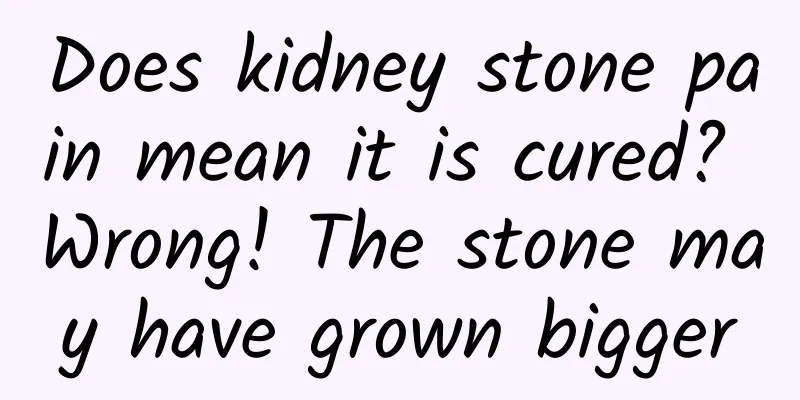Does kidney stone pain mean it is cured? Wrong! The stone may have grown bigger

|
The pain caused by kidney stones can be fatal. But does it mean that kidney stones are no longer painful? Don't be careless, the severity of kidney stones is not proportional to the pain. As the stones grow larger year by year, the condition may worsen without you noticing. How can a small stone be so powerful? Today, Xu Qingquan, chief physician of the Urology and Lithotripsy Center of Peking University People's Hospital, will talk to you about kidney stones. Ignoring stones may lead to kidney failure Kidney stones are a type of urinary stone disease. They are very common in clinical practice. They are commonly known as stones growing in the kidneys, including ureteral stones, bladder stones, and urethral stones. Kidney stone pain is usually caused by stones obstructing the urinary tract, causing spasms in the ureteral smooth muscles and colic. Xu Qingquan introduced that the pain of kidney stones is often manifested as dull pain or colic, often located in the costovertebral angle, waist or abdomen, and is often paroxysmal, usually called renal colic. In acute attacks, severe cases feel like being cut by a knife. Generally speaking, if the patient rolls on the ground in pain, is in extreme pain, has a pale face and sweats, antispasmodics and analgesics should be used immediately. In addition, because the stones damage the kidneys or ureters, patients often have microscopic hematuria or macroscopic hematuria. If kidney stones are not treated actively, they are likely to cause urinary tract infection. Long-term kidney stones may also lead to urinary tract stenosis, urinary tract obstruction, urinary tract infection, etc., and then develop into hydronephrosis, renal failure, and even eventually uremia. Stones contain a lot of calcium and can be easily found by abdominal ultrasound or CT. Experts say that except for stones smaller than 5 mm, which can be treated conservatively with antispasmodic and analgesic drugs, drinking plenty of water and exercising moderately, there are three main treatments for most kidney stones: extracorporeal shock wave lithotripsy, percutaneous nephrolithotomy, and ureteroscopy. Among them, extracorporeal shock wave lithotripsy, as the name suggests, is carried out outside the body, using an electric shock wave generator to generate high pressure to break the stones into fine sand particles, which are then excreted from the body with urine. It is suitable for stones in various sections of the ureter and kidney stones, and the stone size does not exceed 2 cm. It is not necessarily a good thing for the painful stones to become quiet. When kidney stones are not present, patients are the same as normal people. However, the absence of pain does not mean that everything is fine. The severity of the stones is not directly proportional to the pain. In the early stages of kidney stones, most patients will not experience obvious symptoms. However, as the stones continue to grow and increase in number, long-term stimulation of the renal mucosa will cause inflammation and infection. In addition, long-term stone blockage and ureteral hydrops will cause renal function damage, even kidney atrophy and functional impairment. Some patients may also develop tumors due to long-term stimulation. It hurts once, and then it doesn't hurt anymore, so I don't need to worry about it? According to experts, nearly half of the patients hold this mentality. In fact, the absence of pain does not mean that the stones have been expelled. With long-term obstruction, the ureter expands due to water accumulation, and the pain is reduced. Such "quiet" kidney stones have pitted many patients. Experts remind that if the pain disappears after one time, it does not mean that the patient is cured. As the stones grow larger year by year, the condition may worsen unknowingly. Therefore, patients with kidney stones must have regular follow-up visits and treatment to ensure that no complications of the stones occur. These bad habits give birth to stones Kidney stones are composed of crystals (calcium oxalate, calcium phosphate, magnesium ammonium phosphate, urea) and matrix (proteins such as hexosamine). The formation of kidney stones is due to certain factors that increase the concentration of crystal substances in urine or reduce their solubility, resulting in a supersaturated state, precipitation of crystals, and local growth and accumulation, eventually forming stones. Kidney stones affect a wide range of people. In recent years, with the improvement of living standards, more and more young people are also suffering from this disease. Why? From the composition of the stones, it is not difficult to see that it is closely related to lifestyle habits. Overeating, not liking to drink water, not liking to exercise, and drinking strong tea and coffee frequently may induce kidney stones. Excessive intake of oxalic acid About 67% of kidney stones are caused by calcium oxalate. Therefore, if you often eat foods with high oxalate content such as grains, berries, green leafy vegetables, coffee, etc., oxalic acid can easily precipitate in the urine. Experts point out that oxalic acid itself has little impact on health, but people at high risk of stones should limit their intake. For example, people with a family history of kidney stones, obesity, hyperthyroidism, gout, urinary tract infection, obstruction, long-term bed rest, etc. People who don't like to drink water may be too busy at work or just don't like to drink water, which leads to insufficient water intake throughout the day, resulting in reduced urine output and increased urine concentration in the kidneys, which makes it easy for crystals to precipitate and increases the risk of stone formation. Experts point out that drinking more water is the simplest, most accurate and most effective way to prevent kidney stones. "Drinking a lot of water helps dilute urine, so that calcium ions and uric acid in urine will not be oversaturated, preventing the formation of crystals in urine and kidney stones." As living conditions improve, people who like to eat greasy food are attracted to various high-purine delicacies with heavy tastes such as fish, meat, beer, fried and spicy food. High fat, high sugar and high salt not only reduce the amount of fat that can be combined in the intestines, increase urinary calcium and induce stones; meat products can also increase uric acid in the body and reduce citric acid levels, causing uric acid concentration to exceed the balance in the body, precipitate crystal nuclei and increase the risk of kidney stones. Experts pointed out that a reasonable diet is very important, because 60% of stone patients lack citric acid in their bodies. They can take citrus fruits or sugar-free orange juice, lemon juice, lime juice and other citric acid supplements in moderation; people over 50 years old are recommended to eat more calcium-containing foods. Many people who are too lazy to exercise sit for long periods of time at their desks. Lack of exercise, coupled with obesity, will increase the risk of kidney stones. Experts recommend that people get up and walk around regularly during work, and choose appropriate exercise methods based on their age and physical condition. Obesity patients should lose weight appropriately. (Zhong Yanyu) |
<<: World Hemophilia Day | Positive treatment progress brings bright hope
Recommend
My period has been delayed for 4 days and has not come yet
Many women often experience delayed menstruation....
Women's diet: What should women eat in autumn?
Women generally attach great importance to health...
After doing it, it hurts and burns
After sexual intercourse, if a woman feels a burn...
Understand the diseases that cause increased vaginal discharge and the causes of frequent urination in women
What diseases may cause increased leucorrhea: 1. ...
How to choose complementary food for babies? What are the misunderstandings about adding complementary food to babies?
Scientific feeding is what every mother wants to ...
Causes, prevention and treatment of dental caries
Dental caries is actually a common oral disease. ...
Does your body temperature rise during menstruation?
During a woman's menstrual period and ovulati...
Why does it hurt when women urinate?
Urination is something people need to do every da...
Why do I have leg pain every time I have my period?
Many women feel leg pain during their menstruatio...
What causes pain during menopause?
Sexual intercourse is an integral part of a coupl...
Is it okay for women not to wear bras at home?
As women, we all know that when we wear underwear...
Why do women sweat a lot due to physical weakness?
Many modern people are under great pressure at wo...









